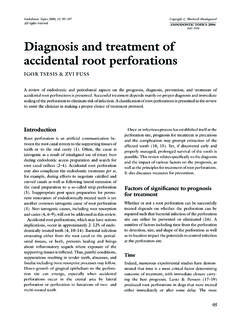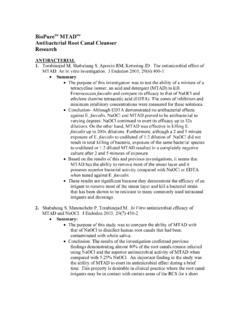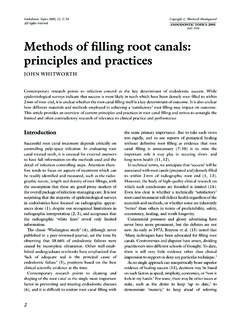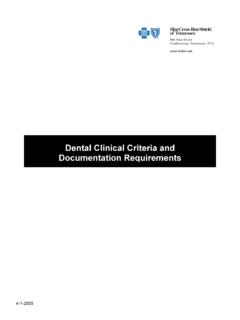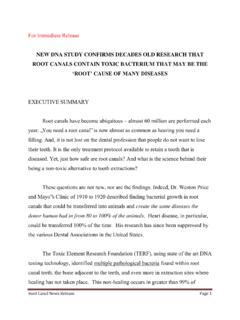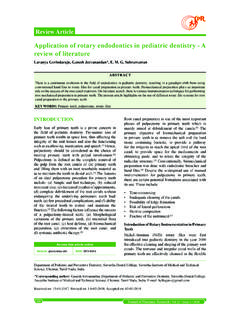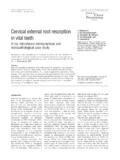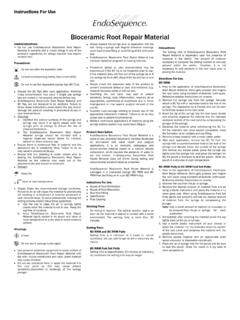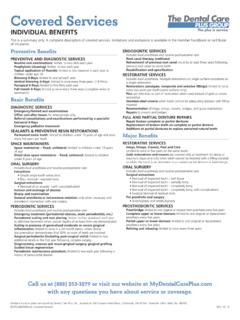Transcription of Characterization of Successful Root Canal Treatment
1 Knowing the outcome of root Canal Treatment (RCT) is determinant to substantiate the clinical decision making process, especially when RCT is weighed against the extraction of natural teeth or replacement by prosthetic elements. The ideal scenario in all clinical situations should combine healing/prevention of disease (apical periodontitis) and the functional retention of the tooth. Understanding the risk factors associated with endodontic failure is a key factor to increase the chances of success. The logical action is to reverse the existing disease, which requires intervention to neutralize the bacterial invasion and disrupt the bacterial biofilm within the complex anatomy. Success is more predictable when the immune host defenses are favorable. However, success has different meanings to the dentist, to the patient and to the tooth itself. The life of an endodontically treated tooth depends on the accuracy of the diagnosis and planning, excellence of disinfection, instrumentation and filling procedures (antimicrobial strategies, root Canal shaping and coronal and apical seal) and finally the rehabilitation management.
2 The interpretation of constant or intermittent pain and/or discomfort associated with apical periodontitis (AP) in endodontically treated tooth may be suggestive of endodontic failure. The success features of RCT, namely absence of pain, regression of AP, tight seal of Canal and coronal spaces, and recovery of tooth function, must be reevaluated over time. In case of doubt between success and failure, cone beam computed tomography (CBCT) could be indicated for detection and precise localization of AP. The possibility of map reading on CBCT images characterizes the real multidimensional structure, providing accurate information on the presence, absence or regression of AP. The survival of an endodontically treated tooth implies understanding the biological and mechanical outcomes as multifactorial events over the individual s life span. The objective of this review of literature is to discuss relevant factors associated with patient s health, tooth and dentist that could account for a Successful RCT.
3 Characterization of Successful root Canal TreatmentCarlos Estrela1, Roberto Holland2, Cyntia Rodrigues de Ara jo Estrela3, Ana Helena Gon alves Alencar1, Manoel Dami o Sousa-Neto1, Jesus Djalma P cora11 Department of Stomatologic Sciences, School of Dentistry, UFG - Federal University of Goi s, Goi nia, GO, Brazil2 Department of Restorative Dentistry, School of Dentistry, UNESP - Univ Estadual Paulista, Ara atuba, SP, Brazil3 Department of Endodontics, School of Dentistry, University of Cuiab , Cuiab , MT, BrazilCorrespondence: Prof. Dr. Carlos Estrela, Pra a Universit ria s/n, Setor Universit rio, 74605-220, Goi nia, GO, Brasil. Tel: +55-62-3209-6254. e-mail: Key Words: success, failure, outcome, apical periodontitis, is the expected outcome after root Canal Treatment (RCT), regardless of the clinical conditions. However, predicting success usually requires adopting a referential or criteria, and presupposes that the patient is healthy.
4 It is estimated that RCT should be considered completed when the tooth is permanently restored and in function (1). RCT clinical success can be analyzed based on different points of view, with specific values that involve the dentist, the patient or the tooth itself. References for the dentist are the value of symptom (clinical silence - absence of pain), the value of image ( root Canal space completely filled with no evidence of periapical inflammation), and the value of clinical condition (a well-restored and functioning tooth). The dentist s skills are crucial to interpret correctly the radiographic features and establish a diagnostic hypothesis. For the patient, the value of symptom (no pain) is essential. Apart from this, RCT success is associated with predictive aspects that eliminate the need of interventions and establishes Treatment conclusion. The success for the tooth itself is associated with absence of disease ( root Canal infection or periapical inflammation).
5 The life of an endodontically treated tooth implies understanding that biological and mechanical events have a multifactorial nature and cannot be viewed separately. Ideally, it is expected to preserve the largest possible number of teeth until the end of life. Successful RCT prevents pain, apical periodontitis (AP) and tooth loss, but it is a real challenge because several clinical conditions can contribute, alone or in combination, for a poor prognosis, namely root Canal perforation, overfilling, endodontic and periodontal lesion, root fracture, periapical biofilm, traumatic dental injury, fracture of instrument, AP, root resorption, and periodontal conditions should be carefully examined before RCT. Preoperative diagnosis of dental pulp and/or periapical tissues is an important reference ISSN 0103-6440 Brazilian Dental Journal (2014) 25(1): 3-11 Dent J 25(1) 2014 4C. Estrela et establish case prognosis. The dentist s health represents a human aspect that is frequently neglected and can also be a risk factor for the occurrence of intraoperative procedural errors.
6 Human error may be associated with stress, working conditions, and lack of attention, adequate planning and sufficient knowledge of new technologies. Renouard and Charrier (2) discussed some human factors that could induce accidents and reported that as far as the interactions between the individual and the working environment, errors could be related to other people (life ware), technology (hardware), documentation (software) and environment. The objective of this review of literature is to discuss relevant factors associated with patient s health, tooth and dentist that could account for a Successful RCT. Table 1 enumerates determinant aspects associated with the health of the individual, the tooth and the professional that must be carefully observed for a Successful RCT. The Value of DiagnosisEstablishing a correct diagnosis is essential for planning clinical procedures. A favorable prognosis in RCT relies on the endodontist s scientific experience level and skills.
7 The challenge is to overcome the complex Canal morphology, neutralize the microbial pathogenicity regardless of the type and duration of infection, and disrupt the bacterial biofilm. Host s defense (immune response) is fundamental in this or periapical inflammatory diseases are usually identified by the consequences of tissue aggressions. The main purpose of Canal therapy is the removal of the causative - bacterial, chemical, mechanical and physical etiological - agents. During the diagnosis, it is essential to recognize the clinical conditions that could have led to tissue response, such as dental caries, pain, inflammation, primary infection, secondary infection, symptomatic/asymptomatic AP, periapical abscess with/without sinus tract, open/closed cavity, history of traumatic dental the clinical factors associated with pulpal and periapical pain may provide important information for planing the therapeutic strategies and predicting RCT outcomes.
8 The most frequent diagnosis of pulpal pain has been associated with symptomatic pulpitis and hyper-reactive pulpalgia, and the most frequent periapical pain is symptomatic AP of infectious origin. Endodontic diagnosis and local factors associated with pulpal and periapical pain suggest that the important clinical factor in pulpal pain is closed pulp chamber and caries, and is periapical pain is open pulp chamber (3). Understanding the general clinical condition (patient s systemic health) and local (clinical conditions of the tooth) favors the first impression to predict a possible outcome of RCT. The impact of patient s age, smoking status, initial Treatment versus retreatment, root Canal system exposed to salivary contamination prior to Treatment , and the type of instrumentation on RCT outcome were recently evaluated Table 1. Determinant factors associated with health of individual, tooth and professional that must be carefully observed for RCT success.
9 Determinants associated with the individual- Patient s age- Oral health (periodontal disease) - Systemic health (systemic diseases)- Patient s collaboration (level of patient s knowledge about the importance of health and of the RCT) Determinants associated with the tooth- Diagnosis of dental pulp and/or periapical tissue previously to RCT- Dental morphology (dental group - anterior, premolar and molar; dental development disturbances)- RCT planning- Time, extension and type of the infectious process- Understanding the disinfection process, the selection of the antimicrobial agents (irrigant solution, intracanal dressing, filling material, quality of coronary restoration)- RCT ( root Canal space completely filled, with filling material ending 1-2 mm from the radiograph apex, overfilling, root perforation, fracture of instrument, endoperiodontal lesion, traumatic dental injury)- Type of restoration (composite resin, metallic restoration, unitary prosthesis with or without intraradicular post, extensive dental rehabilitation)- Control and longevity of the RCT- Selection of the cases and gumptionDeterminants associated with the professional- Stress- Work environment- Lack of attention- Lack of planning- Domain of new technologies- Technical ability and knowledge (academic level - student, general clinician, specialist, experienced specialist, professor)
10 Braz Dent J 25(1) 20145 Successful root Canal Treatment (4). The integrity of a patient s nonspecific immune system, which has been neglected in earlier investigations, is a significant predictor for endodontic Treatment outcome, and should receive more attention. The immune status of the patient, and the quality of the root filling showed a great influence on RCT outcome in a cohort study (4).Several non-endodontic diseases suggest a typical case of AP. The differential diagnosis of diseases of non-endodontic and endodontic origin should always be made carefully. Radiolucent or radiopaque images in the mandibular or maxillary areas surrounding the root apexes may be a sign of non-endodontic disease, and may be misdiagnosed as AP (5-7). root Canal Infection and its ConsequencesThe periapical inflammation represents a natural biological defense response, caused by several etiologic agents. The model of the inflammatory response is similar in other parts of the organism.










